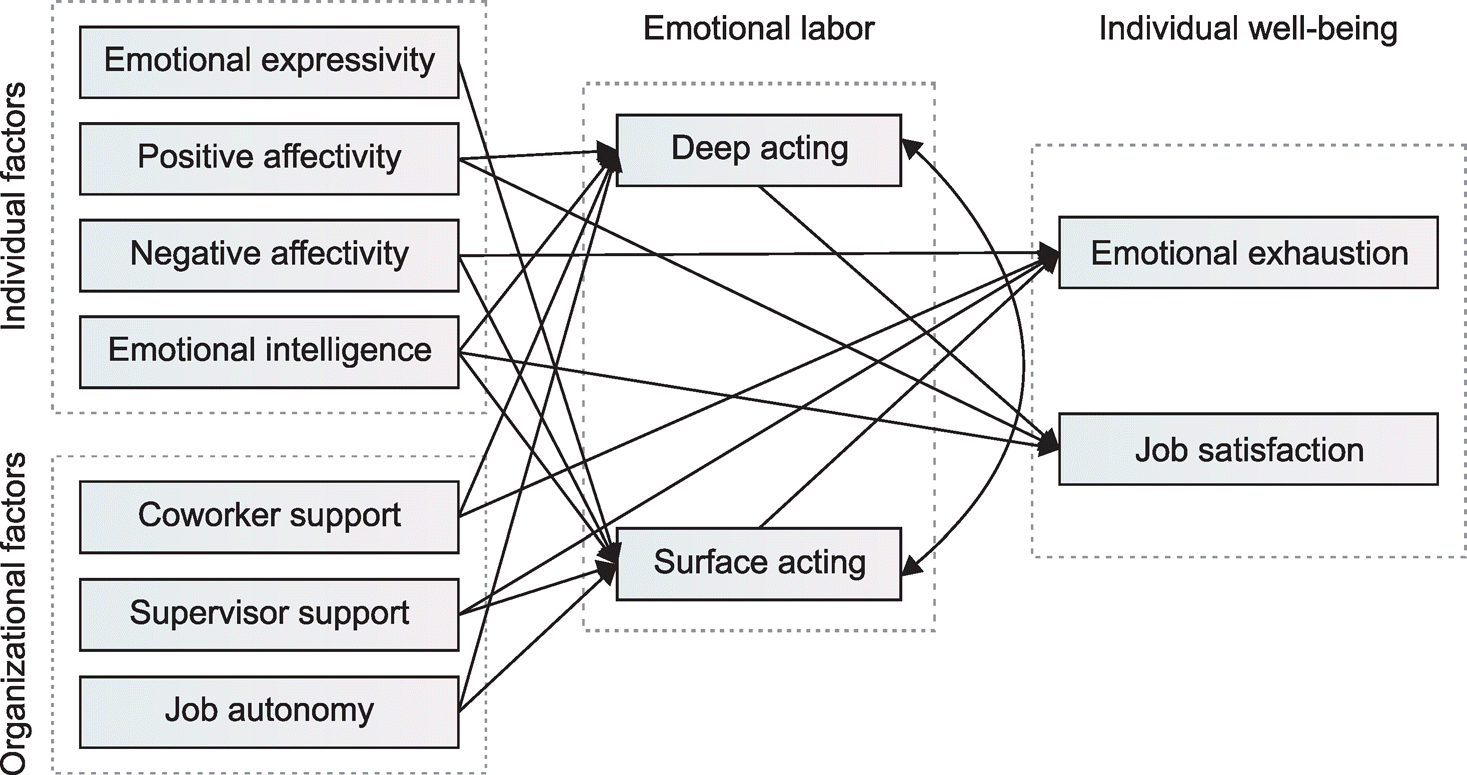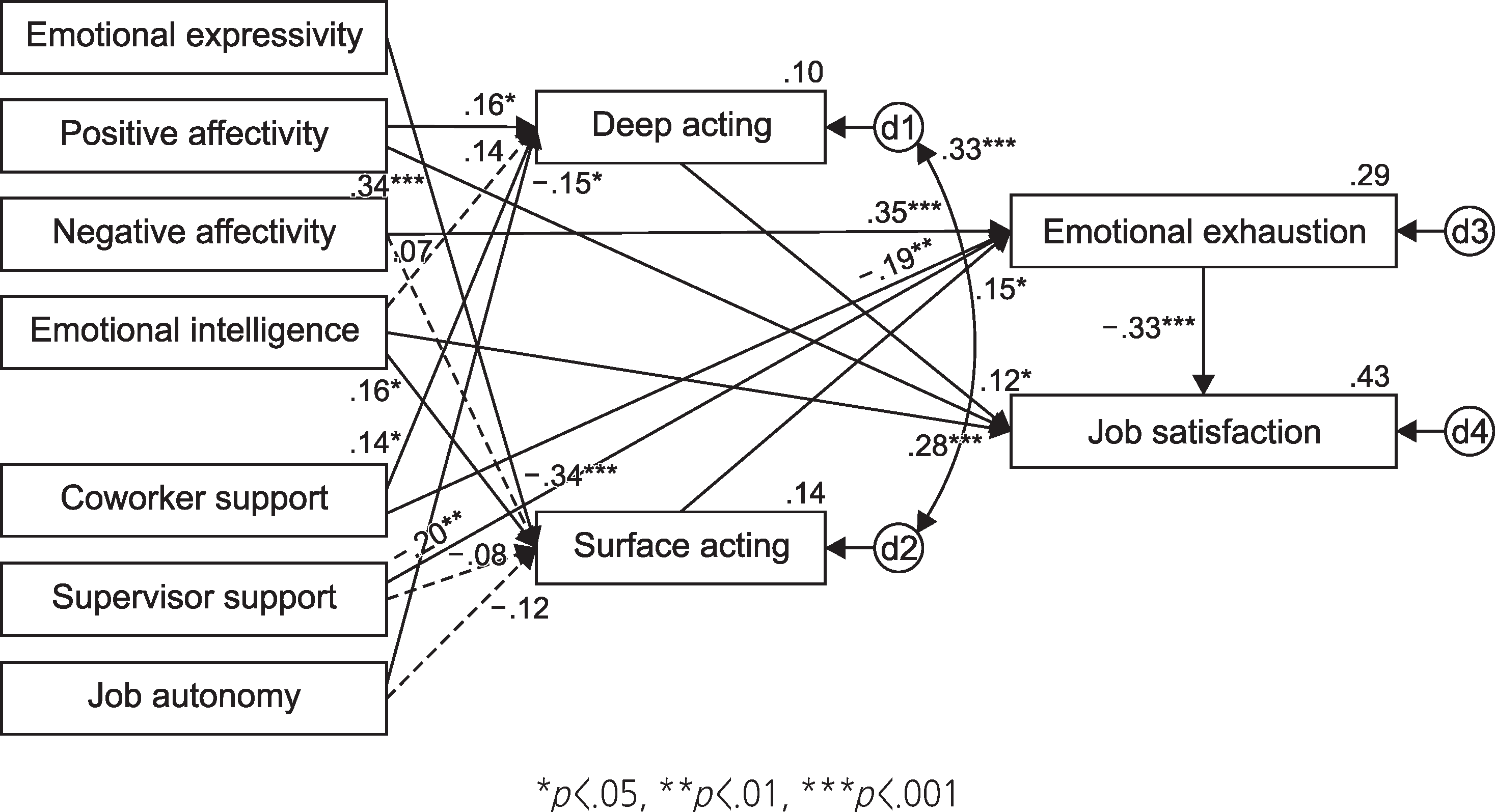Abstract
Purpose
This study was conducted to investigate the influence of emotional expressivity, emotional intelligence, affectivity, job autonomy, social support, and emotional labor on clinical nurses’ individual well-being and to provide guidelines for interventions and strategies for its improvement.
Methods
The sample consisted of 207 nurses recruited from a general hospital in Korea. The participants completed a structured self-report questionnaire comprising measures of emotional expressivity, emotional intelligence, positive affectivity, negative affectivity, job autonomy, supervisor support, coworker support, deep acting, surface acting, emotional exhaustion, and job satisfaction. Data were analyzed using SPSS statistics 22.0 and AMOS 22.0.
Results
The final model was a good fit for the data based on the model fit indices. In the path analysis, surface acting, negative affectivity, supervisor support, and coworker support had statistically significant effects on emotional exhaustion, explaining 29.0% of the variance. Deep acting, emotional exhaustion, positive affectivity, and emotional intelligence had statistically significant effects on job satisfaction, explaining 43.0% of the variance.
Conclusion
Effective strategies to improve clinical nurses’ individual well-being should focus on surface acting, deep acting, affectivity, social support, and emotional intelligence. The results of this study can be utilized as base data to manage emotional labor and improve clinical nurses’ individual well-being.
Go to : 
References
1. Grandey AA. Emotion regulation in the workplace: A new way to conceptualize emotional labor. Journal of Occupational Health Psychology. 2000; 5(1):95–110. https://doi.org/10.1037//1076-8998.5.1.95.
2. Yom YH, Lee HZ, Son H. Clinical nurses’ experience of emotional labor. Journal of Korean Clinical Nursing Research. 2016; 22(3):314–326. https://doi.org/10.22650/JKCNR.2016.22.3.314.
3. Han SG. Occupations requiring emotional labor. Korea Research Institute for Vocational Education and Training Issue Brief. 2013; 26:1–4.
4. Yom YH, Son HS, Lee HZ, Kim MA. The relationship between physical discomfort, burnout, depression, social supports and emotional labor of clinical nurses in Korea. Journal of Korean Clinical Nursing Research. 2017; 23(2):222–235. https://doi.org/10.22650/jkcnr.2017.23.2.222.
5. Kim MY, Choi HJ. Structural equation modeling on nurses’ emotional labor including antecedents and consequences. Journal of the Korean Data and Information Science Society. 2016; 27(1):143–154. https://doi.org/10.7465/jkdi.2016.27.1.143.

6. Jeong YH, Lee CS, Choe H, Park JY. Emotional labor, job satisfaction and turnover intention of nurses in the regional general hospital. The Journal of the Korea Contents Association. 2016; 16(1):708–719. https://doi.org/10.5392/JKCA.2016.16.01.708.

7. Diefendorff JM, Erickson RJ, Grandey AA, Dahling JJ. Emotional display rules as work unit norms: A multilevel analysis of emotional labor among nurses. Journal of Occupational Health Psychology. 2011; 16(2):170–186. https://doi.org/10.1037/a0021725.

8. Kammeyer‐Mueller JD, Rubenstein AL, Long DM, Odio MA, Buckman BR, Zhang Y, et al. A meta‐analytic structural model of dispositonal affectivity and emotional labor. Personnel Psychology. 2013; 66(1):47–90. https://doi.org/10.1111/peps.12009.
9. Kang HJ, Jeon HG, Kim MY. An empirical analysis of the impact of hospital employees’ emotional intelligence on emotional labor strategies and innovative activities. The Journal of the Korea Contents Association. 2015; 15(12):387–406. https://doi.org/10.5392/JKCA.2015.15.12.387.

10. Park HJ. Emotional labour, emotional expression and burnout of clinical nurses. Journal of Korean Academy of Nursing Administration. 2009; 15(2):225–232.
11. Lim HJ, Park KS, Ban HJ, Lee NR, Lee YM, Lee ES, et al. The influence of emotional labor and social support on burnout of clinical nurses. Journal of Digital Convergence. 2017; 15(1):255–266. https://doi.org/10.14400/JDC.2017.15.1.255.

12. Wi SM, Yi YJ. Influence of emotional labor on job satisfaction, intent to leave, and nursing performance of clinical nurses. Journal of Korean Academy of Nursing Administration. 2012; 18(3):310–319.

13. Shin SH, Jang KS. The influence of emotional labor strategy on job burnout and job engagement in psychiatric nurses. Korean Public Health Research. 2016; 42(4):33–43.
14. Cheng C, Bartram T, Karimi L, Leggat SG. The role of team climate in the management of emotional labour: Implications for nurse retention. Journal of Advanced Nursing. 2013; 69(12):2812–2825. https://doi.org/10.1111/jan.12202.

15. Chou HY, Hecker R, Martin A. Predicting nurses’ well‐ being from job demands and resources: A cross‐sectional study of emotional labour. Journal of Nursing Management. 2012; 20(4):502–511. https://doi.org/10.1111/j.1365-2834.2011.01305.x.
16. Kim YS, Chung EY, Kim JN, Seo YJ. The effect of emotional labor on job stress, burnout and job satisfaction of hospital nurses. Korean Public Health Research. 2014; 40(4):75–88.
17. Wong CS, Law KS. The effects of leader and follower emotional intelligence on performance and attitude: An exploratory study. The Leadership Quarterly. 2002; 13(3):243–274. https://doi.org/10.1016/s1048-9843(02)00099-1.

18. Jang RJ, Kang YS, Kim YM. The relationships in emotional intelligence, job satisfaction, and quality of nursing service in hospital nurses. Journal of the Korea Academia-Industrial Cooperation Society. 2016; 17(6):326–337. https://doi.org/10.5762/KAIS.2016.17.6.326.

19. Yang FH, Chang CC. Emotional labour, job satisfaction and organizational commitment amongst clinical nurses: A questionnaire survey. International Journal of Nursing Studies. 2008; 45(6):879–887. https://doi.org/10.1016/j.ijnurstu.2007.02.001.

20. Adil A, Kamal A. Moderating role of affectivity in emotional labor and emotional exhaustion among customer services representatives. Psychological Studies. 2013; 58(1):89–98. https://doi.org/10.1007/s12646-013-0178-x.

21. Yu JP. Structural equation models: Concepts and understanding. Seoul: Hannarae Publishing Company;2012. p. 1–567.
22. Kring AM, Smith DA, Neale JM. Individual differences in dispositional expressiveness: Development and validation of the Emotional Expressivity Scale. Journal of Personality and Social Psychology. 1994; 66(5):934–949. https://doi.org/10.1037//0022-3514.66.5.934.

23. Han JW. The influences of emotional expressivity on physical health and subjective well-being [master’s thesis]. Seoul: Seoul National University;1997. p. 1–69.
24. Jung HW. An empirical study on the effect of emotional intelligence on organizational effectiveness [dissertation]. Busan: Pusan National University;2007. p. 1–181.
25. Watson D, Clark LA, Tellegen A. Development and validation of brief measures of positive and negative affect: The PANAS scales. Journal of Personality and Social Psychology. 1988; 54(6):1063–1070. https://doi.org/10.1037//0022-3514.54.6.1063.

26. Lee HH, Kim EJ, Lee MK. A validation study of Korea Positive and Negative Affect Schedule: The PANAS Scales. Korean Journal of Clinical Psychology. 2003; 22(4):935–946.
27. Breaugh JA. The measurement of work autonomy. Human Relations. 1985; 38(6):551–570. https://doi.org/10.1177/001872678503800604.

28. Lee KE, Park KK. The determinants of professionals’ dual commitment to the organization and profession by parallel model. Korean Management Review. 2002; 31(2):551–574.
29. House JS. Work stress and social support. Reading (MA): Addison-Wesley Publishing Company;1981. p. 1–156.
30. Ko JW. Articles: The effects of personality traits on job satisfaction. Korean Journal of Sociology. 1999; 33:359–387.
31. Brotheridge CM, Lee RT. Development and validation of the emotional labour scale. Journal of Occupational and Organizational Psychology. 2003; 76(3):365–379. https://doi.org/10.1348/096317903769647229.

32. Jang EH, Park D, Lee DH, Lee DH, Choi YH. A validation study on the translated Korea version of Emotional Labor Scale (ELS) in hospitality organizations. Indian Journal of Science and Technology. 2015; 8(Suppl 5):129–134. https://doi.org/10.17485/ijst/2015/v8is5/62026.

33. Maslach C, Jackson SE. The measurement of experienced burnout. Journal of Organizational Behavior. 1981; 2(2):99–113. https://doi.org/10.1002/job.4030020205.

34. Choi HY, Chung NW. Perfectionism tendency, social support, and burnout among counselors. The Korean Journal of Health Psychology. 2003; 8(2):279–300.
35. Price JL, Mueller CW. A causal model of turnover for nurses. Academy of Management Journal. 1981; 24(3):543–565.

36. Baek M. Effects of coaching program on nurses’s emotional intelligence, coaching skills, self-efficacy and job satisfaction [dissertation]. Gwangju: Chonnam National University;2010. p. 1–123.
37. Chai GM. Advanced statistics by using SPSS and AMOS. Paju: Yangseowon;2014. p. 1–433.
38. Yom YH. Analysis of burnout and job satisfaction among nurses based on the job demand-resource model. Journal of Korean Academy of Nursing. 2013; 43(1):114–122. https://doi.org/10.4040/jkan.2013.43.1.114.

39. Lee JH. The influence of service training, organizational support, and arbitration support among large superstore workers’ work performance and emotional labor. Journal of Arbitration Studies. 2018; 28(2):179–200.
40. Park KA, Back HS, Han JS. The effects of REBT group counseling on the job stress, positive affect, negative affect and self-esteem of nurses. The Korea Journal of Counseling. 2007; 8(3):951–963. https://doi.org/10.15703/kjc.8.3.200709.951.
Go to : 
Table 1.
General Characteristics of the Subjects (N=207)
Table 2.
Descriptive Analysis for Study Variables (N=207)
Table 3.
Standardized Direct, Indirect, Total Effect in the Modified Model




 PDF
PDF ePub
ePub Citation
Citation Print
Print




 XML Download
XML Download